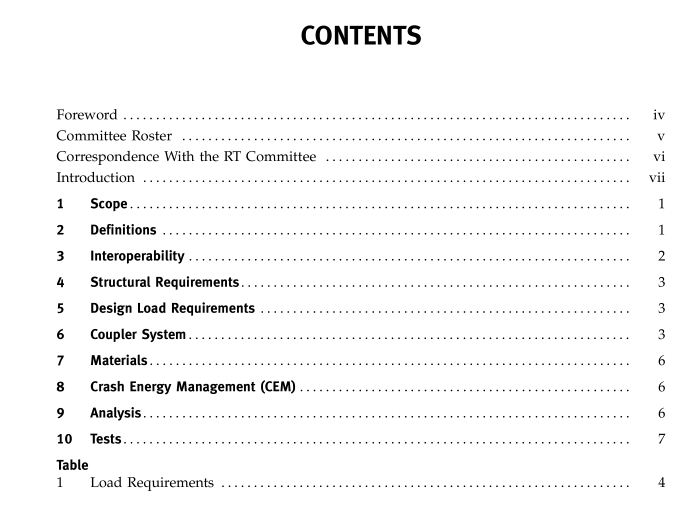ASME RT-2 pdf download

ASME RT-2 pdf download Safety Standard for Structural Requirements for Heavy Rail Transit Vehicles
4 STRUCTURAL REQUIREMENTS
The carbody shall withstand the maximum loads con- sistent with the operational requirements and achieve the required service life under normal operating condi- tions. The carbody design shall be based on the design load requirements specified in section 5. The capability ofthe structure to meet these requirements shall be dem- onstrated by calculation and/or appropriate proof of design testing. The strength of connections between structural mem- bers of the end frame for Items 6 through 11 in Table 1 shall exceed the ultimate load-carrying capacity of the weakest member joined. For these load cases, the ulti- mate load-carrying capacity is established by applying the load at the location and in the direction specified in Table 1 but increased in magnitude to the maximum load that can be resisted by the structure, as determined by observing that further increase in deflections will result in a decrease in the load capable of being carried by the structure. References to sheathing in Table 1 refer only to structurally related (load carrying) sheathing.
4.1 Welding Design of welded structures shall be in accordance with AWS D15.1, AWS D1.1 for steel, and AWS D1.2 for aluminum.
4.2 Design Parameter Tolerance The allowable stresses for the loads specified in section 5 shall consider the limiting cases of dimensional toler- ances, manufacturing processes, workmanship, and other manufacturing conditions.
4.3 Demonstration of Strength and Structural Stability It shall be demonstrated by analysis (section 9) and/or tests (section 10) that the requirements of section 5 are achieved.
4.4 Truck to Carbody Attachment A mechanism for attaching the completely assembled truck, including the bolster if used, to the carbody shall be provided, with strength levels in accordance with section 5. The trucks shall remain attached to the car- body when the vehicle is raised unless first intentionally detached. The ultimate horizontal strength of the attachment mechanism shall be as specified to secure the entire truck to the carbody during collisions at any possible position of the truck in its vertical suspension travel. This shall include the condition of the vehicle raised off the track with the truck hanging from the vehicle, and shall not depend upon external vertical loading nor upon bolster anchor rods.
5 DESIGN LOAD REQUIREMENTS This section defines load requirements to be used for the design of heavy rail transit vehicles, including static loads representing normal and exceptional conditions. The structure of the carbody shall be completely assem- bled with the loads of all equipment included before the specified loads are applied. Each specified force shall be applied over the minimum area necessary to limit local yielding or buckling, with its center of action at the location specified. In Table 1, where no permanent deformation is required, localized plastic deformation is permitted, provided it has no effect on the structural integrity of the complete carbody.
5.1 Crashworthiness The carbody shall be constructed in such a way as to
(a) minimize the possibility of injury to occupants during a collision from such causes as the detachment of parts of the carbody or falling equipment mounted in the ceiling or on the roof
(b) minimize the loss of occupant volume resulting from structural collapse or structural penetration
(c) provide for a progressive controlled collapse of energy absorption zones of the carbody structure Structural energy absorption zones shall be located at the ends of the carbody structure and shall be activated prior to crush of other carbody structures, following the sequence and magnitude of collapse as specified in Table 1. Table 1 further specifies required strengths for structural elements such as collision posts and corner posts to protect passengers and operators from struc- tural penetration and loss of occupant volume in the event of a collision with another vehicle or obstruction. Other requirements in Table 1 specify design criteria for vehicle anticlimbing protection in vehicle-to-vehicle collisions, and carbody roll-over strength.









